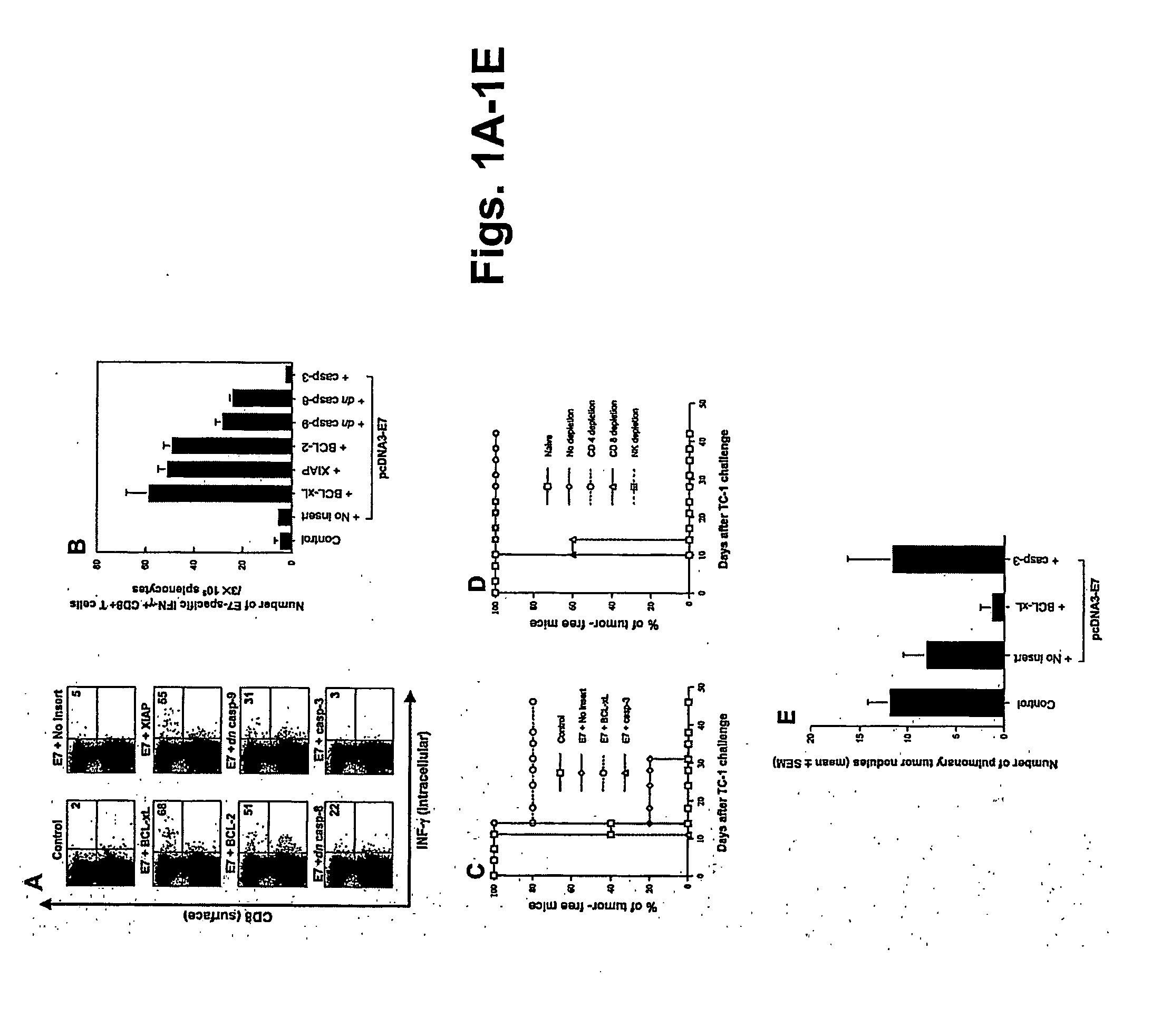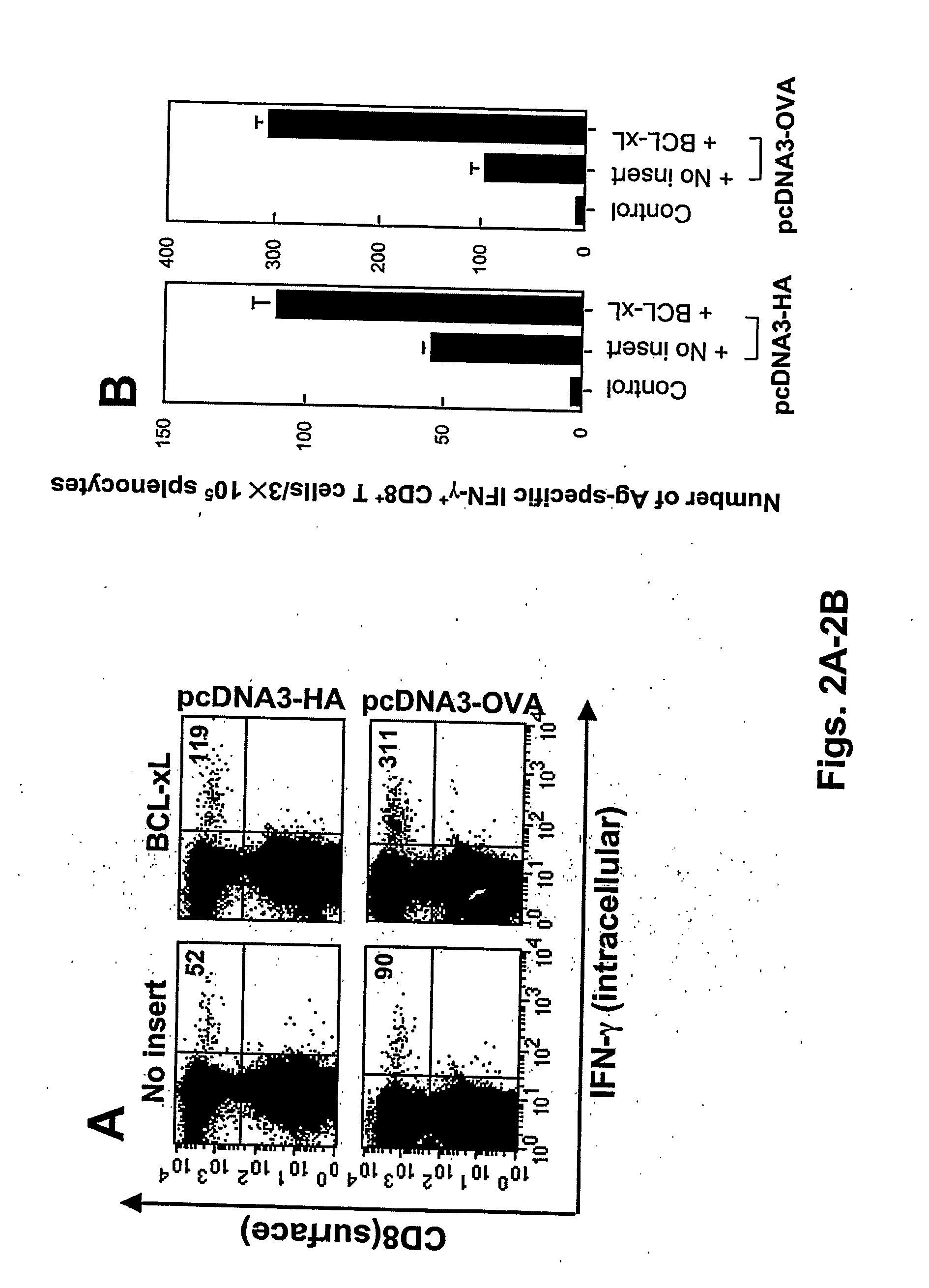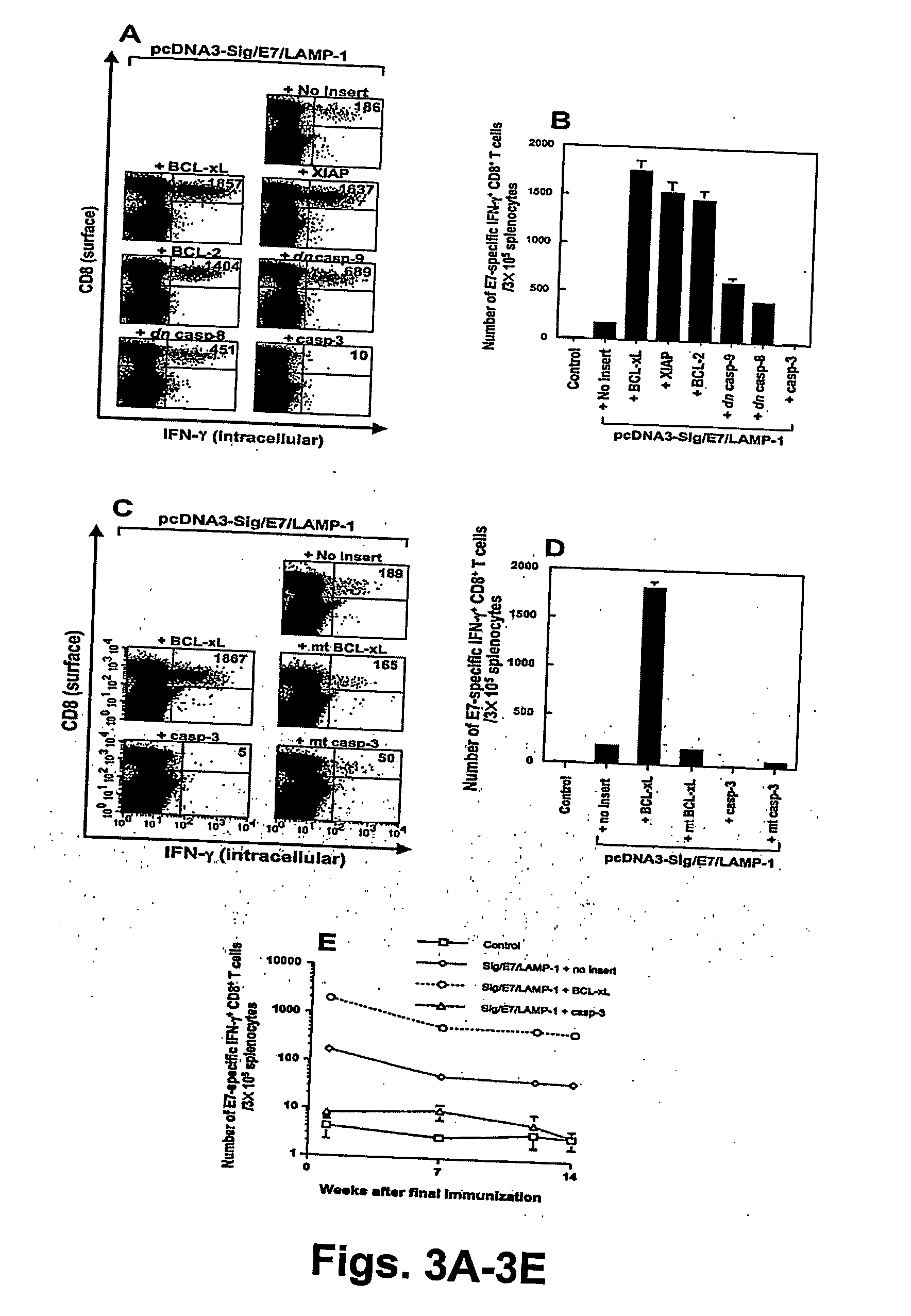Molecular vaccines employing nucleic acid encoding anti-apoptotic proteins
a nucleic acid encoding and protein technology, applied in the field of molecular biology, immunology and medicine, can solve the problems of limited life span of dcs, hindering their long-term ability to prime antigen-specific t cells, etc., and achieve the effects of increasing the number of antigen-specific cd8+ ctls, increasing the number of cd4+ th cells, and increasing the specificity of cd8+ ctl
- Summary
- Abstract
- Description
- Claims
- Application Information
AI Technical Summary
Benefits of technology
Problems solved by technology
Method used
Image
Examples
example ii
Enhancing DNA Vaccine Potency by Prolong Dendritic Cell Life and Employing Intracellular Targeting
(This example incorporates by reference T W Kim et al., J. Immunol. 171:2970-2976, 2003 Sep. 15)
A. Materials and Methods
[0291] Plasmid DNA constructs and DNA preparation. The generation of pcDNA3, pcDNA3-E7, pcDNA3-Sig / E7 / LAMP-1, pcDNA3-CRT / E7, and pcDNA3-HSP70 / E7 has been described previously (See Example I and Ji et al., supra; Cheng et al., supra; and Chen et al., 2000, supra). pSG5 plasmids encoding Bcl-xL or mt 7 (our mtBcl-xL) were generated as described previously (Cheng, E H, 1996, supra) Cheng, E. H., B. The DNA was amplified and purified according to Chen et al., supra).
Mice: See Example I.
DNA vaccination. See Example I. C57BL / 6 mice were immunized with 2 μg of pcDNA3 encoding E7, CRT / E7, E7 / HSP70, or Sig / E7 / LAMP-1 mixed with 2 μg of pSG5 or pSG5-Bcl-xL. The mice received a booster with the same dose 1 wk later.
Intracellular cytokine staining and flow cytometry anal...
example iii
DNA Encoding Serine Protease Inhibitor-6 (Serpinb9) Enhances Potency of DNA Vaccine
(This example incorporates by reference T W Kim et al., Cancer Res. 64: 400-405, 2004 Jan. 1)
A. Materials and Methods
[0310] Plasmid DNA Constructs and DNA Preparation. The generation of pcDNA3-E7, pcDNA3-CRT / E7, pcDNA3-E7 / HSP70 and pcDNA3-Sig / E7 / LAMP-1 are described above or in references cited above. Generation of pcDNA3-ETA(dII) / E7 was described in C F Hung et al., 2001, Cancer Res 61:3698-3703; Wu et al., WO 03 / 085085). For generation of pcDNA3-SPI-6, SPI-6 was first amplified with PCR using mouse cDNA as the template and a set of primers, 5′-cccgaattcatgaatactctgtctgaagga-3′ [SEQ ID NO:87]and 5′-tttggatcctggagatgagaacctgccaca-3′ [SEQ ID NO:88]. The amplified product was then cloned into the EcoR I / BamH I sites of the pcDNA3 vector.
[0311] To generate the inactive mtSPI-6 containing the P14 mutation (T327R), most of the SPI-6 ORF was amplified from pSVTf / SPI-6 (Sun, J et al., 1997, J Biol Che...
example i
Mice. See
[0312] DNA Vaccination. See Example I. C57BL / 6 mice were immunized with 2 μg of pcDNA3 encoding E7, CRT / E7, E7 / HSP70, ETA(dII) / E7, or Sig / E7 / LAMP-1, mixed with 2 μg of pcDNA3, pcDNA3-SPI-6, or pcDNA3-mt SPI-6. The mice received a booster with the same dose one week later.
[0313] Intracellular Cytokine Staining and Flow Cytometry Analysis. See Example I for details. Splenocytes from each vaccination group were incubated for 16 hours with either 1 μg / ml of E7 peptide containing an MHC class I epitope for detecting E7-specific CD8+ T cell precursors or 10 μg / ml of E7 peptide (aa 30-67) containing an MHC class II epitope for detecting E7-specific CD4+ T cell precursors.
In Vivo Tumor Protection and Tumor Treatment Experiments. See Example I.
[0314] Survival of Dendritic Cell Line (DC-1). An immortalized DC line (Shen, Z et al., 1997, J Immunol, 158:2723-30) was provided by Kenneth Rock (University of Massachusetts, Worcester, Mass.). Subclones were generated by the present inv...
PUM
| Property | Measurement | Unit |
|---|---|---|
| nucleic acid | aaaaa | aaaaa |
| length | aaaaa | aaaaa |
| composition | aaaaa | aaaaa |
Abstract
Description
Claims
Application Information
 Login to View More
Login to View More - R&D
- Intellectual Property
- Life Sciences
- Materials
- Tech Scout
- Unparalleled Data Quality
- Higher Quality Content
- 60% Fewer Hallucinations
Browse by: Latest US Patents, China's latest patents, Technical Efficacy Thesaurus, Application Domain, Technology Topic, Popular Technical Reports.
© 2025 PatSnap. All rights reserved.Legal|Privacy policy|Modern Slavery Act Transparency Statement|Sitemap|About US| Contact US: help@patsnap.com



